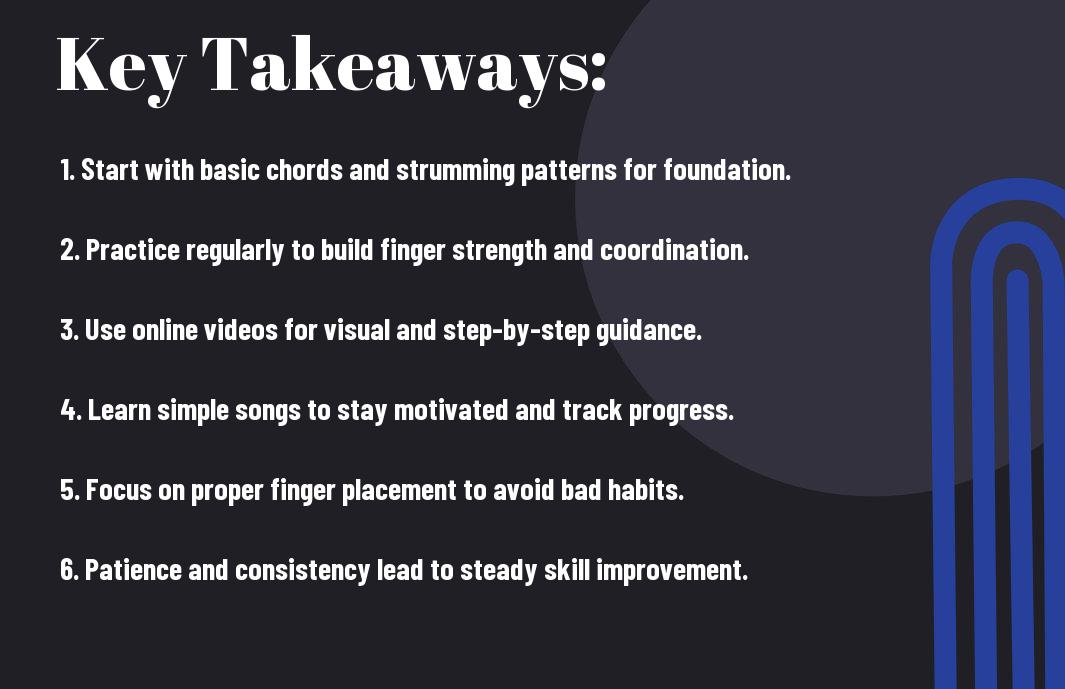With my experience in teaching guitar, I know that starting your musical journey can be overwhelming yet exciting. In this post, I will guide you through important guitar tutorials designed specifically for beginners, helping you develop your skills and confidence. You will learn basic chords, strumming patterns, and techniques that will set a strong foundation for your playing. By following these tutorials, you can avoid common pitfalls and enjoy a positive learning experience as you commence on your path to becoming a proficient guitarist.

The First Chords: Your Essential Building Blocks
Starting your guitar journey hinges on mastering a few key chords. These foundational sounds open the door to countless songs and styles, enabling you to play along with your favorite tracks sooner than you think. I often recommend focusing on basic major and minor chords first, as they are the backbone of most music genres. As you begin to explore these chords, you’ll quickly realize how they can enhance your playing and boost your confidence. Let’s dive deeper into the magic behind them.
The Magic of Major and Minor Chords
Major and minor chords form the essence of Western music, creating different emotional landscapes. Major chords—like C, G, and D—exude a bright, uplifting quality, while minor chords—such as A minor, E minor, and D minor—bring a more somber, introspective feel. I find that experimenting with both types allows you to express a wider range of emotions in your playing and songwriting. These distinct auditory experiences set the stage for everything you’ll create on your guitar.
How to Form and Transition Between Basic Chords
Forming and transitioning between basic chords requires practice and patience. Start with common shapes, using your index, middle, and ring fingers to press down the correct strings. As you build muscle memory, I recommend practicing switching between chords like G and C, then adding in D. Aim for smoothness and clarity, and don’t rush—slow, deliberate practice will yield better results. Consistent repetition will not only improve your finger dexterity but also enhance your confidence as you move through chords effortlessly.
Your journey will benefit greatly from integrating chord transitions into your daily practice regimen. Set aside time where you focus solely on moving from one chord to another without strumming, then gradually introduce strumming patterns. Start slow, ensuring each note rings clear before speeding up. Utilizing a metronome can also help maintain a steady rhythm as you work on making those transitions flow. Once you feel comfortable, challenge yourself by combining different sequences, which will expand your repertoire and keep your practice sessions engaging.
Strumming Patterns: The Rhythm of Your Journey
Strumming patterns serve as the heartbeat of your guitar playing, shaping the mood and style of every song you tackle. Understanding how to create varied strumming rhythms not only enhances your music but also boosts your overall confidence as a guitarist. By mastering a few fundamental patterns, you’ll gain an invaluable toolkit that supports your journey through countless genres, enabling you to express yourself musically. Whether you’re strumming along to your favorite songs or gearing up to write your own, these skills will empower you to play with conviction and ease.
Common Strumming Patterns Every Beginner Should Know
Familiarizing yourself with a variety of strumming patterns can add dynamic flair to your playing. Some necessary patterns include the down-down-up-up-down-up, which works perfectly for pop songs, and the down-down-down-up-up-down for a classic rock favorite. Additionally, the down-up-down-up pattern creates a light, bouncing feel suited for folk tunes. These basic patterns lay the groundwork for more complex rhythms—take time to practice them until you feel comfortable and ready to incorporate them into your music.
Tips for Developing Consistent Timing and Rhythm
Focusing on maintaining a steady beat is vital for improving your strumming technique. Using a metronome can significantly aid in developing your sense of timing; gradually increase the tempo as you become comfortable. Recording yourself while practicing can provide immediate feedback on the consistency of your strumming and help to identify areas for improvement. Strumming with a backing track is another enjoyable way to lock in rhythm. Ultimately, consistency will come naturally with practice, so approach each session with intention and patience, letting the rhythm guide your progress.
- steady beat
- metronome
- backing track
Exploring timing techniques gives you tools to refine your skills even further. Playing along with your favorite songs not only enhances enjoyment but also strengthens your timing, as you are compelled to match their rhythms. Simple finger exercises can keep your hands nimble, while subdividing beats can help you gain a deeper understanding of rhythm. Practice with diverse styles to broaden your rhythmic knowledge and to keep your techniques fresh. Perceiving rhythm as a conversation between your guitar and the music will help you flow naturally through various styles.
- timing techniques
- finger exercises
- diverse styles
Essential Techniques: Mastering the Basics
Building a solid foundation is vital for any beginner guitarist. Mastering basic techniques sets the stage for future growth and allows for greater expression in your playing style. You’ll want to focus on key skills such as finger placement, hand positioning, and getting comfortable with your instrument. By investing time in these vitals, you’ll be well-equipped to tackle more complex chords and songs down the line.
Finger Placement and Hand Positioning
Proper finger placement and hand positioning can significantly affect your sound and ease of playing. Position your thumb behind the neck of the guitar while arching your fingers to press down on the strings close to the fret. This minimizes string buzz and ensures a clean tone. Pay attention to keeping your wrist relaxed and your fingers curved, allowing for greater agility when transitioning between chords.
Introduction to Fingerpicking vs. Strumming
Both fingerpicking and strumming have their unique applications, and I find using them interchangeably can enhance my playing. While strumming involves using a pick or fingers to sweep across the strings, fingerpicking requires plucking individual strings with your fingers. Each technique produces different textures and moods, allowing for varied expressions in your music. You’ll often discover that songs lend themselves better to one method over the other, depending on their style and intention.
Strumming provides a driving rhythm that can energize a song, perfect for upbeat tracks or full-bodied chords. Meanwhile, fingerpicking brings a delicate and intricate quality that adds depth to ballads or acoustic pieces. As you familiarize yourself with both techniques, you might find certain songs resonate more with your playing style. Take the time to practice both; the flexibility will open new opportunities in your musical journey and keep your practice sessions engaging.
Fun and Engaging Songs to Boost Your Confidence
Learning music can feel overwhelming at first, but I’ve discovered that playing fun and engaging songs not only elevates your mood but also boosts your confidence. Picking songs that you love makes practice feel less like a chore and more of a joyous adventure. From a bop you can hum along to at a party to a classic ballad that tugs at the heartstrings, these songs can empower you to improve while having fun. Plus, when you successfully play a favorite tune, the sense of accomplishment is undeniable.
Easy Songs for Beginners to Learn Quickly
To ease into your guitar journey, start with easy songs that you can learn quickly. Tracks like “Three Little Birds” by Bob Marley or “Horse with No Name” by America only require a few chords, making them perfect for beginners. Each song is structured simply, allowing you to practice chord transitions without feeling overwhelmed. You’ll feel a rush of achievement as you strum along to familiar tunes that bring back memories or simply make you smile.
The Role of Repetition in Mastering Songs
Repetition is your best friend when it comes to mastering songs on the guitar. By practicing a specific section multiple times, you fortify muscle memory and improve your timing. This process may seem tedious at first, but you’ll experience growth in both skill and confidence. Gradual refinement through repetition leads to a cleaner performance, allowing you to enjoy the music more fully and play it more fluidly.
Engaging in repetition not only solidifies the technical aspects of your playing but also helps you unlock your personal style within a song. Each time you revisit a piece, you can discover nuances or variations that make it feel like your own. Playing the same chord progression over and over enhances your comfort level and lets you focus on other aspects like dynamics and expression. It’s a vital step that transforms a simple piece into a truly personal musical experience.
Beyond the Basics: Next Steps for Aspiring Guitarists
As you progress in your guitar journey, it’s necessary to explore advanced techniques and styles that align with your musical interests. You might consider delving into fingerpicking, improvisation, or even songwriting. Online resources like PLAY ACOUSTIC GUITAR 1 – Quick-Start for Beginners can provide structured lessons to help you take those next steps, ensuring a smooth transition into more demanding concepts while having fun along the way.
Exploring Music Theory and Its Importance
Diving into music theory significantly enhances your understanding and appreciation of guitar playing. Familiarizing yourself with scales, chords, and progressions lays the foundation for improvisation and composition. Knowledge of theory empowers you to break down songs, comprehend their structure, and create variations that resonate with your unique style.
The Value of Jam Sessions and Online Communities
Joining jam sessions and participating in online communities can massively elevate your guitar skills. Interacting with diverse musicians exposes you to varying styles and techniques that can inspire and challenge your playing. I’ve found that sharing my journey in forums or social media groups builds connections and motivates me to practice consistently.
Jam sessions provide a platform where you can collaborate, exchange ideas, and receive instant feedback from fellow musicians. Engaging with online communities, such as dedicated forums or social media groups, opens doors to countless resources, including tutorials, practice tips, and live demonstrations. Not only does this environment foster creativity, but it also serves as a support system that keeps you accountable and encouraged throughout your learning journey. Whether you’re strumming your first chord or developing complex solos, these interactions keep you excited about playing.
Summing up
Now that you’ve explored guitar tutorials for beginners, I hope you feel empowered to start your musical journey. By engaging with these resources, you can develop your skills at your own pace, understanding the fundamentals and gradually building your confidence. Practice regularly, and don’t hesitate to seek others for advice or inspiration. Your dedication will lead to progress, and soon you’ll find yourself playing your favorite songs with ease. Enjoy the process; each note brings you closer to mastering the guitar!




